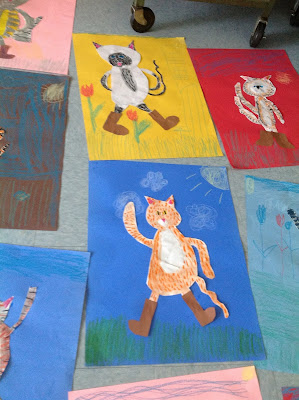I found one of the best little books in a forgotten corner of Borders before it went out of business. The book was called
"The Midnight Unicorn" by Neil Reed. In this wonderful story a little girl imagines that a statue of a unicorn in the park comes to life and takes her and her faithful dog on an adventure around the world. The pages are embossed too, which makes for a neat texture link.
After the story I showed my first and second graders how to draw the unicorn using shapes. Then we put ourselves on top of our unicorns. We drew with Crayola Portfolio Series Oil Crayons on turquoise paper. For the background I give the kids free rein. They get to put themselves somewhere they want their unicorn to take them.
 |
| Lots of kids wanted to go to the island that was at the end of the book. |
 |
| This unicorn is taking her girl to an amusement park. There's a Ferris Wheel in the bottom right corner. |
 |
| This unicorn is taking his person into outer space. Note the aliens. |
 |
| This unicorn helped her person find a pot of gold at the end of the rainbow. |









































